Papacy began 14 March 1800 Successor Pope Leo XII Name Pope VII | Ordination 21 September 1765 Papacy ended 20 August 1823 | |
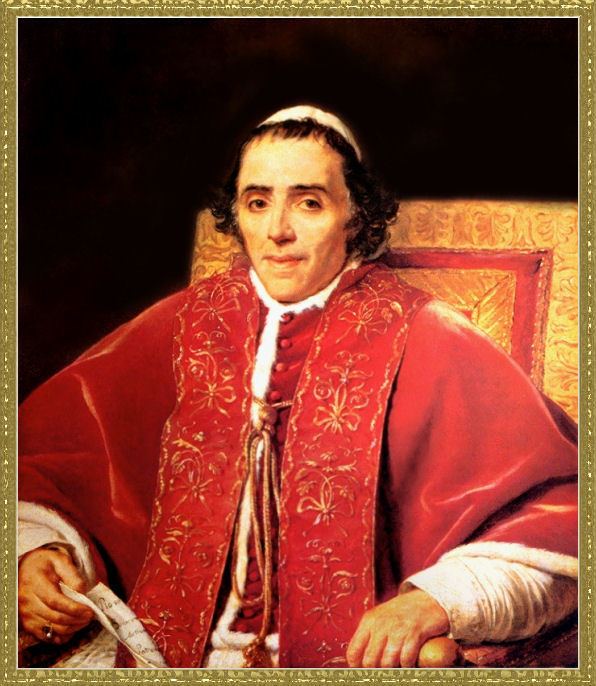 | ||
Created Cardinal 14 February 1785by Pius VI Birth name Barnaba Niccolo Maria Luigi Chiaramonti Parents Scipione Chiaramonti, Giovanna Coronata Ghini Similar People Josephine de Beauharnais, Jacques‑Louis David, Napoleon, Pope Pius XII, Mario Monicelli | ||
Quote of the day pope pius vii
Pope Pius VII (14 August 1742 – 20 August 1823), born Barnaba Niccolò Maria Luigi Chiaramonti, reigned as Pope from 14 March 1800 to his death in 1823. Chiaramonti was also a monk of the Order of Saint Benedict in addition to being a well known theologian and bishop throughout his life.
Contents
- Quote of the day pope pius vii
- Pope Pius VII Wikipedia audio article
- Early life
- Episcopate and cardinalate
- Election
- Negotiations and exile
- Relationship with Napoleon I
- Restoration of the Jesuits
- Opposition to slavery
- Reinstitution of Jewish Ghetto
- Other activities
- Cultural innovations
- Canonizations and beatifications
- The miracle of Pius VII
- Relationship with the United States
- Condemnation of heresy
- Death and burial
- Beatification process
- Monuments
- References
Chiaramonti was made Bishop of Tivoli in 1782, and resigned that position upon his appointment as Bishop of Imola in 1785. That same year, he was made a cardinal. In 1789, the French Revolution took place, and as a result a series of anti-clerical governments came into power in the country. In 1796, during the French Revolutionary Wars, French troops under Napoleon Bonaparte invaded Rome and took as prisoner Pope Pius VI. He was taken as prisoner to France, where he died in 1799. The following year, after a sede vacante period lasting approximately six months, Chiaramonti was elected to the papacy, taking the name Pius VII.
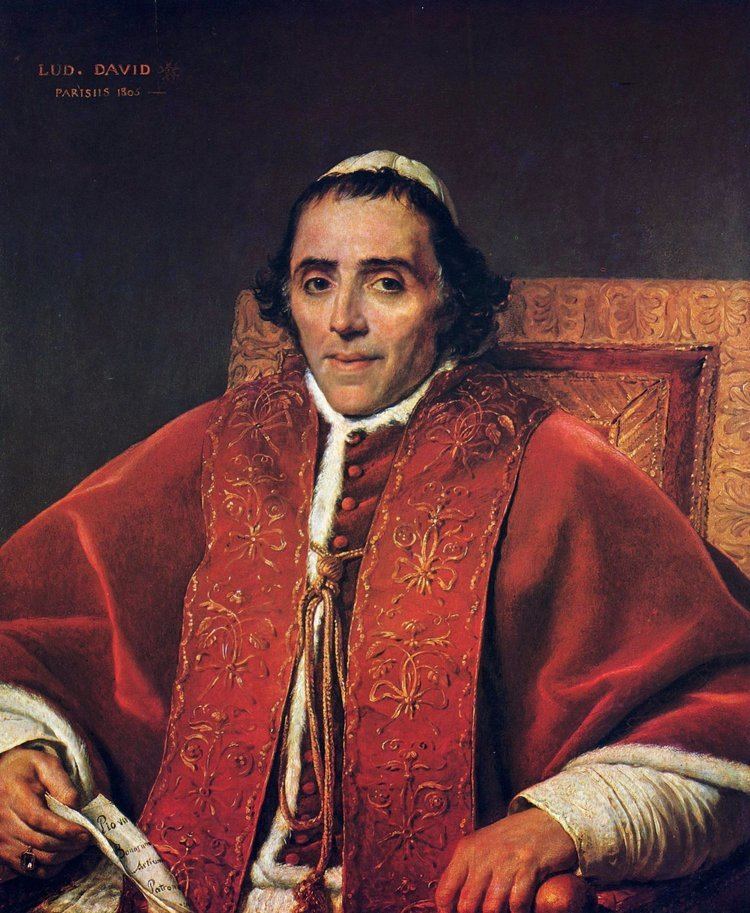
Pius at first attempted to take a cautious approach in dealing with Napoleon. With him he signed the Concordat of 1801, through which he succeeded in guaranteeing religious freedom for Catholics living in France, and was present at his coronation as Emperor of the French in 1804. In 1809, however, during the Napoleonic Wars, Napoleon once again invaded the Papal States, resulting in his excommunication. Pius VII was taken prisoner and transported to France. He remained there until 1814 when, after the French were defeated, he was permitted to return to Rome, where he was greeted warmly as a hero and defender of the faith.
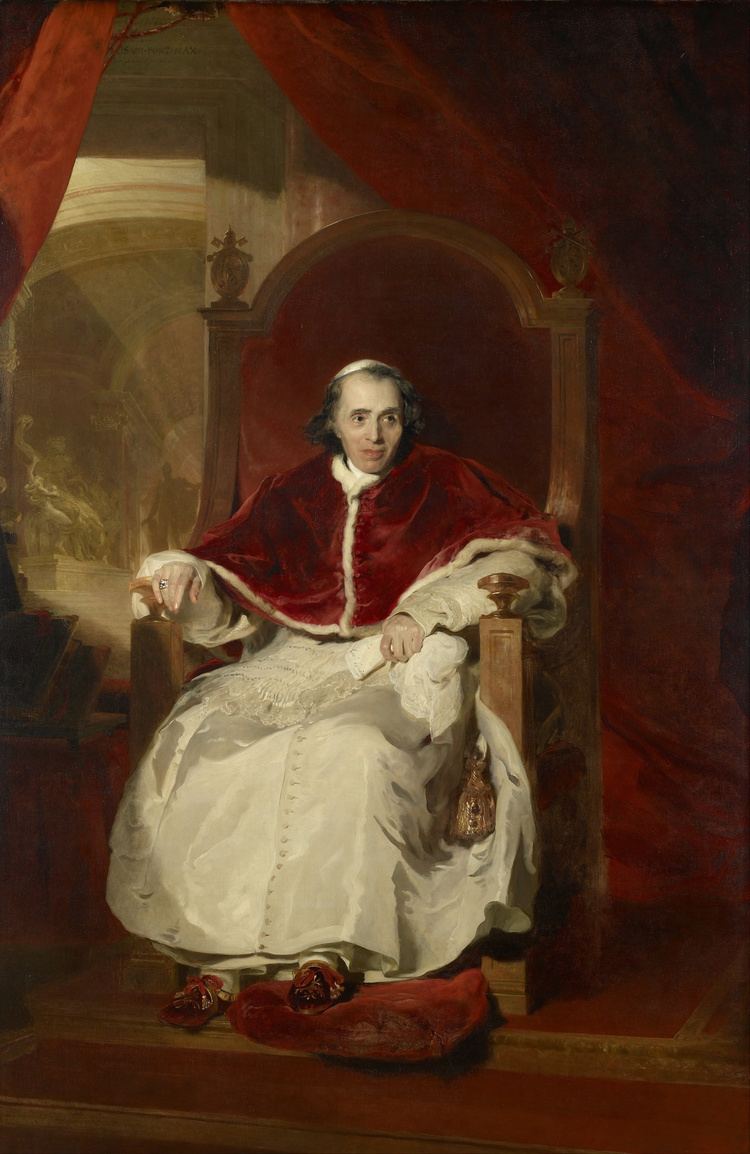
Pius lived the remainder of his life in relative peace. His papacy saw a significant growth of the Catholic Church in the United States, where Pius established several new dioceses. Pius VII died in 1823 at age 81.
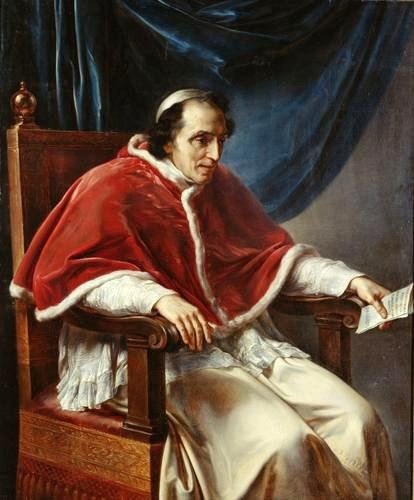
In 2007, Pope Benedict XVI began the process towards canonizing him as a saint, and he was granted the title Servant of God.
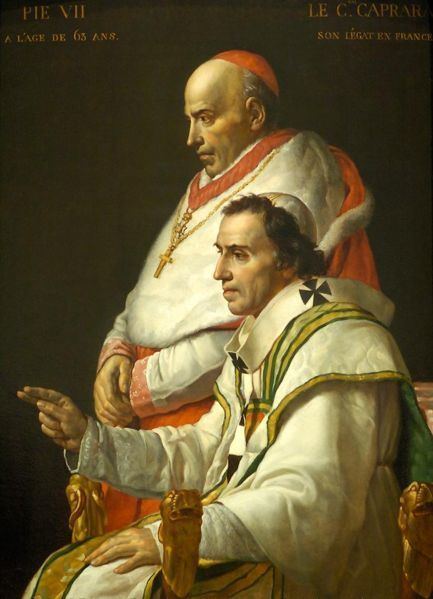
Pope Pius VII | Wikipedia audio article
Early life
Barnaba Chiaramonti was born in Cesena in 1742, the youngest son of Count Scipione Chiaramonti (30 April 1698 - 13 September 1750. His mother, Giovanna Coronata (d. 22 November 1777), was the daughter of the Marquess Ghini; through her, the future Pope Pius VII was related to the Braschi family of Pope Pius VI after marriage on 10 November 1713. Though his family was of noble status, they were not wealthy but rather, were of middle-class stock.
His maternal grandparents were Barnaba Eufrasio Ghini and Isabella de' conti Aguselli. His paternal grandparents were Giacinto Chiaramonti (1673-1725) and Ottavia Maria Altini; his paternal great-grandparents were Scipione Chiaramonti (1642-1677) and Ottavia Maria Aldini. His paternal great-great grandparents were Chiaramonte Chiaramonti and Polissena Marescalchi.
His siblings were Giacinto Ignazio (19 September 1731 - 7 June 1805), Tommaso (19 December 1732 - 8 December 1799) and Ottavia (1 June 1738 - 7 May 1814).
Like his brothers, he attended the Collegio dei Nobili in Ravenna but decided to join the Order of Saint Benedict at the age of 14 on 2 October 1756 as a novice at the Abbey of Santa Maria del Monte in Cesena. Two years after this on 20 August 1758, he became a professed member and assumed the name of Gregorio. He taught at Benedictine colleges in Parma and Rome, and was ordained a priest on 21 September 1765.
Episcopate and cardinalate
A series of promotions resulted after his relative, Giovanni Angelo Braschi was elected Pope Pius VI (1775–99). A few years before this election occurred, in 1773, Chiaramonti became the personal confessor to Braschi. In 1776, Pius VI appointed the 34-year-old Dom Gregory, who had been teaching at the Monastery of Sant'Anselmo in Rome, as honorary abbot in commendam of his monastery. Although this was an ancient practice, it drew complaints from the monks of the community, as monastic communities generally felt it was not in keeping with the Rule of St. Benedict.
In December 1782, the pope appointed Dom Gregory as the Bishop of Tivoli, near Rome. Pius VI soon named him, in February 1785, the Cardinal-Priest of San Callisto, and as the Bishop of Imola, an office he held until 1816.
When the French Revolutionary Army invaded Italy in 1797, Cardinal Chiaramonti counseled temperance and submission to the newly created Cisalpine Republic. In a letter that he addressed to the people of his diocese, Chiaramonti asked them to comply "... in the current circumstances of change of government (...)" to the authority of the victorious general Commander-in-Chief of the French army. In his Christmas homily that year, he asserted that there was no opposition between a democratic form of government and being a good Catholic: "Christian virtue makes men good democrats.... Equality is not an idea of philosophers but of Christ...and do not believe that the Catholic religion is against democracy."
Election
Following the death of Pope Pius VI, by then virtually France's prisoner, at Valence in 1799, the conclave to elect his successor met on 30 November 1799 in the Benedictine Monastery of San Giorgio in Venice. There were three main candidates, two of whom proved to be unacceptable to the Habsburgs, whose candidate, Alessandro Mattei, could not secure sufficient votes. However, Carlo Bellisomi also was a candidate, though not favoured by Austrian cardinals; a "virtual veto" was imposed against him in the name of Franz II and carried out by Cardinal Franziskus Herzan von Harras.
After several months of stalemate, Jean-Sifrein Maury proposed Chiaramonti as a compromise candidate. On 14 March 1800, Chiaramonti was elected pope, certainly not the choice of die-hard opponents of the French Revolution, and took as his pontifical name Pius VII in honour of his immediate predecessor. He was crowned on 21 March in a rather unusual ceremony, wearing a papier-mâché papal tiara as the French had seized the tiaras held by the Holy See when occupying Rome and forcing Pius VI into exile. He then left for Rome, sailing on a barely seaworthy Austrian ship, the Bellona, which lacked even a galley. The twelve-day voyage ended at Pesaro and he proceeded to Rome.
Negotiations and exile
One of Pius VII's first acts was appointing the minor cleric Ercole Consalvi, who had performed so ably as secretary to the recent conclave, to the College of Cardinals and to the office of Cardinal Secretary of State. Consalvi immediately left for France, where he was able to negotiate the Concordat of 1801 with the First Consul Napoleon. While not effecting a return to the old Christian order, the treaty did provide certain civil guarantees to the Church, acknowledging "the Catholic, Apostolic, and Roman religion" as that of the "majority of French citizens".
The main terms of the concordat between France and the pope included:
As pope, he followed a policy of cooperation with the French-established Republic and Empire. He was present at the coronation of Napoleon I in 1804. He even participated in France's Continental Blockade of Great Britain, over the objections of his Secretary of State Consalvi, who was forced to resign. Despite this, France occupied and annexed the Papal States in 1809 and took Pius VII as their prisoner, exiling him to Savona. Despite this, the pope continued to refer to Napoleon as "my dear son" but added that he was "a somewhat stubborn son, but a son still".
This exile ended only when Pius VII signed the Concordat of Fontainebleau in 1813. One result of this new treaty was the release of the exiled cardinals, including Consalvi, who, upon re-joining the papal retinue, persuaded Pius VII to revoke the concessions he had made in it. This Pius VII began to do in March 1814, which led the French authorities to re-arrest many of the opposing prelates. Their confinement, however, lasted only a matter of weeks, as Napoleon abdicated on 11 April of that year. As soon as Pius VII returned to Rome, he immediately revived the Inquisition and the Index of Condemned Books.
Pius VII's imprisonment did in fact come with one bright side for him. It gave him an aura that recognized him as a living martyr, so that when he arrived back in Rome in May 1814, he was greeted most warmly by the Italians as a hero.
Relationship with Napoleon I
From the time of his election as pope to the fall of Napoleon in 1815, Pius VII's reign was completely taken up in dealing with France. He and the Emperor were continually in conflict, often involving the French military leader's wishes for concessions to his demands. Pius VII wanted his own release from exile as well as the return of the Papal States, and, later on, the release of the 13 "Black Cardinals", i.e., the Cardinals, including Consalvi, who had snubbed the marriage of Napoleon to Princess Marie Louise, believing that his previous marriage was still valid, and had been exiled and impoverished in consequence of their stand, along with several exiled or imprisoned prelates, priests, monks, nuns and other various supporters.
Restoration of the Jesuits
On 7 March 1801, Pius VII issued the brief "Catholicae fidei" that approved the existence of the Society of Jesus in Russia and appointed its first superior general as Franciszek Kareu. This was the first step in the restoration of the order. On 31 July 1814, he signed the papal bull Sollicitudo omnium ecclesiarum which universally restored the Society of Jesus. He appointed Tadeusz Brzozowski as the Superior General of the order.
Opposition to slavery
Pius VII joined the declaration of the 1815 Congress of Vienna, represented by Cardinal Secretary of State Ercole Consalvi, and urged the suppression of the slave trade. This pertained particularly to places such as Spain and Portugal where slavery was economically very important. The pope wrote a letter to King Louis XVIII of France dated 20 September 1814 and to the King John VI of Portugal in 1823 to urge the end of slavery. He condemned the slave trade and defined the sale of people as an injustice to the dignity of the human person. In his letter to the King of Portugal, he wrote: "the pope regrets that this trade in blacks, that he believed having ceased, is still exercised in some regions and even more cruel way. He begs and begs the King of Portugal that it implement all its authority and wisdom to extirpate this unholy and abominable shame."
Reinstitution of Jewish Ghetto
Under Napoleonic rule, the Jewish Ghetto had been abolished and Jews were free to live and move where they would. Following the restoration of Papal rule, Pius VII re-instituted the confinement of Jews to the Ghetto, having the doors closed at nightime. .
Other activities
Pius VII issued an encyclical "Diu satis" in order to advocate a return to the values of the Gospel and universalized the feast of Our Lady of Sorrows for 15 September. He condemned Freemasonry and the movement of the Carbonari in the encyclical Ecclesiam a Jesu Christo in 1821. Pius VII asserted that Freemasons must be excommunicated and it linked them with the Carbonari, an anti-clerical revolutionary group in Italy. All members of the Carbonari were also excommunicated.
Pius VII was multilingual and had the ability to speak Italian, French, English and Latin.
Cultural innovations
Pius VII was a man of culture and attempted to reinvigorate Rome with archaeological excavations in Ostia which revealed ruins and icons from ancient times. He also had walls and other buildings rebuilt and restored the Arch of Constantine. He ordered the construction of fountains and piazzas and erected the obelisk at Monte Pincio.
The pope also made sure Rome was a place for artists and the leading artists of the time like Antonio Canova and Peter von Cornelius. He also enriched the Vatican Library with numerous manuscripts and books. It was Pius VII who adopted the yellow and white flag of the Holy See as a response to the Napoleonic invasion of 1808.
Canonizations and beatifications
Throughout his pontificate, Pius VII canonized a total of five saints. On 24 May 1807, Pius VII canonized Angela Merici, Benedict the Moor, Colette Boylet, Francis Caracciolo and Hyacintha Mariscotti. He beatified a total of 27 individuals including Joseph Oriol, Berardo dei Marsi, Giuseppe Maria Tomasi and Crispin of Viterbo.
The "miracle" of Pius VII
On 15 August 1811 - the Feast of the Assumption - it is recorded that the pope celebrated Mass and was said to have entered a trance and began to levitate in a manner that drew him to the altar. This particular episode aroused great wonder and awe among attendants which included the French soldiers guarding him who were in disbelief of what had occurred.
Relationship with the United States
On the United States' undertaking of the First Barbary War to suppress the Muslim Barbary pirates along the southern Mediterranean coast, ending their kidnapping of Europeans for ransom and slavery, Pius VII declared that the United States "had done more for the cause of Christianity than the most powerful nations of Christendom have done for ages."
For the United States, he established several new dioceses in 1808 for Boston, New York City, Philadelphia and Bardstown. In 1821, he also established the dioceses of Charleston, Richmond and Cincinnati.
Condemnation of heresy
On 3 June 1816, Pius VII condemned the works of Melkite bishop Germanos Adam. Adam's writings supported conciliarism, the view that the authority of ecumenical councils was greater than that of the papacy.
Death and burial
In 1822, Pius VII reached his 80th birthday and his health was visibly declining. On 6 July 1823, he fractured his hip in a fall in the papal apartments and was bedridden from that point onward. In his final weeks he would often lose consciousness and would mutter the names of the cities that he had been ferried away to by the French forces. With the Cardinal Secretary of State Ercole Consalvi at his side, Pius VII succumbed to his injury on 20 August at 5 a.m.
He was briefly interred in the Vatican grottoes but was later buried in a monument in Saint Peter's Basilica after his funeral on 25 August.
Beatification process
An application to commence beatification proceedings were lodged to the Holy See on 10 July 2006 and received the approval of Cardinal Camillo Ruini (Vicar of Rome) who transferred the request to the Congregation for the Causes of Saints. The Congregation - on 24 February 2007 - approved the opening of the cause responding to the call of the Ligurian bishops.
On 15 August 2007, the Holy See contacted the diocese of Savona-Noli with the news that Pope Benedict XVI had declared "nihil obstat" (nothing stands against) the cause of beatification of the late pontiff, thus opening the diocesan process for this pope's beatification. He now has the title of Servant of God. The official text declaring the opening of the cause was: "Summus Pontifex Benedictus XVI declarant, ex parte Sanctae Sedis, nihil preclude quominus in Cause Beatificationis et Canonizationis Servi Dei Pii Barnabae Gregorii VII Chiaramonti". Work on the cause commenced the following month in gathering documentation on the late pope.
He has since been elected as the patron of the Diocese of Savona and the patron of prisoners.
The current postulator of the cause is Father Giovanni Farris.
Monuments
Pope Pius VII's monument (1831) in St. Peter's Basilica, adorning his tomb, was created by the Danish sculptor Bertel Thorvaldsen, a Protestant.
